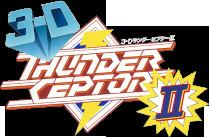Release date(s) JP: December 1986 Cabinet Upright and sit-down Initial release date December 1986 Publisher Namco Platform Arcade game | Genre(s) 3D shooter Arcade system Namco Thunder Ceptor Developer Namco Mode Single-player video game | |
 | ||
CPU 1x Motorola 68000 @ 12.288 MHz,
2x Motorola M65C02 @ 2.048 MHz,
1x Hitachi HD63701 @ 1.536 MHz Sound 1x Yamaha YM2151 @ 3.57958 MHz,
1x Namco CUS30 @ 96 kHz,
1x DAC Similar Thunder Ceptor, Sky Kid Deluxe, Bakuretsu Quiz Ma‑Q Dai Bōken, Tinkle Pit, Bakutotsu Kijūtei | ||
3-D Thunder Ceptor II (3-DサンダーセプターII, Surī-Dī Sandā Seputā Tsū) (or just Thunder Ceptor II) is a 3D shooter arcade game, which was released by Namco in 1986. As the name suggests, it is their sequel to Thunder Ceptor (which was released earlier in the year) and it runs upon the same dedicated hardware, meaning it equaled its predecessor (which had usurped Libble Rabble and Toy Pop) as Namco's most powerful 8-bit game.
Gameplay
For a second time, the player has to take up control of the Thunder Ceptor (which has undergone a colour change); there are also two more commands in this sequel than there were in the original game, and two different types of powerups have been introduced. The colour of the enemies has been changed from gray to green, and most of the older ones have been renamed - several new ones have also been introduced as well, and the obstacles (there are also three new types of them as well here) can now be killed by firing a bomb at them (which means the player will no longer have to fly into them all to remove them from the game at the expense of having the Thunder Ceptor's power decrease by one once it is resurrected). This was also the only game with 3D glasses support that Namco released during their time in the arcades.
